Making Our Yards Safe for Blue Jays
Important warnings about birdbaths, feeders, and especially peanut butter!
(Listen to the radio version here.)
Summer is ostensibly going to last for another 5 weeks, but birds are gearing up for autumn. A bazillion hummingbirds are showing up in my yard right now. We planted bee balm last fall and added a few cardinal flowers this spring. Both flowers time their blooming for hummingbird migration, providing the maximum service for hummingbirds exactly when they get the maximum value for themselves, depending on hummingbirds for pollination.
I’ve been babysitting Walter just about every day, meaning I can’t spend hours in my yard or sitting at a window facing my birdbaths, so I haven’t seen a single warbler at them yet. I have noticed a few Nashville Warblers feeding in my shrubs and even sitting on the chain-link fence behind the bee balm.
About half the time when I look at the birdbaths, I see up to four robins drinking and bathing. The other birds I’m consistently seeing there are Blue Jays.
The Blue Jays that hatched this year are still hanging out loosely with their parents and siblings—the babies have a bit softer coloring than they will when they are adults. Their parents have been molting, so they look much, much scruffier than the young birds. One who flies to my window feeder is completely bald, but if I move away from my desk to grab my camera, he or she flies off, so I don’t have pictures. I suspect that one may be one of two Blue Jays I photographed in August 7, 2020—one was entirely bald and the other had just a few straggly crest feathers—or an offspring of one of them.
The Blue Jay I had as an education bird in the 90s, Sneakers, always molted her head feathers all at once, while another Blue Jay I had for several years never did, so I suspect this may be a genetic feature.
I have a good dozen Blue Jays visiting my dogwood and other berry plants and my feeders right now, and as Blue Jay migration kicks in, I’ll see more and more of them in my yard. I had 23 or 24 in my big platform feeder all at once on September 26, 2021.
I live right below Hawk Ridge, and 2021 broke the all-time Blue Jay record with at least 59,170. But even more flew past in 2022—last fall’s 60,523 set a new record. The biggest flights are always in September, but paying attention to jays in August is well worth it. Providing native berry- and nut-producing shrubs and trees is wonderful not only for jays but a whole assortment of great birds.
People tend to think of Blue Jays as bossy and aggressive at feeders, but chickadees are far more aggressive—we sentimental humans just have pre-conceived notions about sweet, adorable chickadees with their baby-like large heads, and about noisy, “bullying” jays and crows. And those pre-conceived notions squelch our objectivity even when we watch these birds with our own eyes. Chickadees never sit together in a feeder, eating side-by-side, because they each need too much personal space. Most birds use vocalizations and posture before they resort to violence to work out differences, but when a year’s batch of juvenile chickadees start joining fall flocks before they understand all the rules, a few of them do get into actual fights.
Blue Jays hardly ever squabble with one another at feeders. Even when one jay outright steals food from another, the thief just grabs the food without attacking the victim, who in turn doesn’t fight back or vow revenge but simply finds another morsel. Jays do take eggs and chicks from other birds’ nests to feed their own growing young. That is heartbreaking for the robins and other birds whose nests are robbed, and for any people paying attention to those nests, but the jays need a lot of protein to feed their own four or five nestlings. No one thinks of the thousands of tiny caterpillars and other insects killed by a pair of chickadees to provide protein for their nestlings.
Except when a jay is close to a nest, robins and other songbirds benefit from having jays in the neighborhood because Blue Jays yell their heads off, alerting everyone within hearing range when more dangerous predators are about. Birds do mob Blue Jays during the breeding season, but only when jays approach their nests.
At our feeders, other birds scurry away the moment a Blue Jay flies in. I suspect that’s in part because Blue Jays are relatively big and have rounded wings and a long tail. Based on that shape, plus the fact that both the crest and the bright blue color aren’t noticeable as jays fly, a lot of visitors at Hawk Ridge mistake passing Blue Jays for Sharp-shinned Hawks.
It’s a pretty low-risk error for a birder, but the extra second a songbird might take to double-check an identification could well be its last second of life, so of course birds scatter when anything shaped like that flies in. But when we pay attention, we notice those same little birds return to the feeder when they realize it’s just a Blue Jay. Blue Jays might be a little agitated when they first alight on a feeder, squawking once or twice with their crest raised, but when they settle in to eat, down goes the crest along with their volume.
The measures we take to make our yards welcoming and safe for Blue Jays help plenty of other birds, too. First, remember that birds both bathe and drink from our birdbaths. Changing the water every day or two not only keeps birdbath water cleaner for drinking but also prevents mosquito eggs and larvae from developing into adults. Blue Jays are far, far more vulnerable to West Nile virus than we humans are, but considering how many mosquito-borne illnesses we humans are susceptible to and how many disease-carrying mosquitoes breed in small pools of water, keeping birdbaths clean is as important for human health as it is for birds. And never, ever add anything to water that will prevent algal growth—it can be toxic. If you clean the birdbath often enough, the jet stream from a hose will take care of most algae problems. If not, a stiff wire brush will do the trick.
Blue Jays are drawn to feeders for peanuts, corn, and sunflower seeds. Peanuts and corn both get moldy after getting wet. That mold produces extremely dangerous aflatoxins, so it’s very important to dispose of any peanuts and corn within a day or two after they get wet. Sunflower seeds can also get moldy, so never offer more sunflower hearts than birds will eat in a day or two. If you provide sunflower seeds in the shell and some start sprouting, you know they are sitting out too long and getting too wet to be healthful for jays or other birds.
Peanuts and corn sold for human, livestock, and pet consumption must be tested for aflatoxins. Unfortunately, there is not such a requirement for peanuts or corn sold for bird and wildlife feeding, and there have been at least a few occasions when peanuts or corn that failed testing were sold for wildlife feeding, so I only buy peanuts at my local grocery store. I don’t feed cracked corn at all, but if you do offer it, I recommend getting it from a farm-supply feed store.
Blue Jays also visit our feeders for suet. Raw suet and fat trimmings are fine when the weather is cold, but quickly grow rancid when the temperature rises above that of our refrigerators. Rendering the suet—heating it to liquefy it and skimming away the impurities that float to the top—makes it last much longer.
The only recent time I bought what was labeled as a pure suet cake from a bird-feeding store, my birds barely touched it and I ended up throwing it out. I pay close attention to what my favorite backyard Pileated Woodpecker, BB, eats. He seems to prefer suet cakes supplemented with mealworms. This summer several Blue Jays have been eating that, too.
A favorite food of Blue and Canada Jays, Black-capped and Boreal Chickadees, and some woodpeckers is peanut butter. I don’t like providing “natural” peanut butter to birds—the oils separate, making the surface too gooey.
But non-natural peanut butter can be even more dangerous. Xylitol has become the sweetener of choice in a lot of peanut butters labeled “no sugar added,” and now some companies are unethically listing it in the ingredients not as xylitol but as “birch sugar.”
[On edit August 19, thanks to my friend Martha Poole providing this information from NC State University’s website]:
The ASPCA Animal Poison Control Center recommends being on the lookout for any ingredient that includes the letters “xyl.” Synonyms for xylitol:
1,4-anhydro-d-xylitol
Anhydroxylitol
birch bark extract
birch sugar
d-xylitol
xylite
xylitylglucoside
Zylatol
Make sure if you offer peanut butter at all that you read the label to ensure that it doesn’t have any artificial sweeteners, which at best have zero nutritional value. None have been tested for effects on wild birds, and xylitol by any name is known to be extremely toxic to dogs, causing hypoglycemia, liver damage, and possible death. Even though a great many people give their dogs peanut butter as a treat and to coat some medications, and even though its toxicity to dogs is well known, companies adding it to peanut butter don’t provide any warnings for dog owners. Food products never need to be tested to ensure their safety to birds, but one published study shows that xylitol is also very toxic to birds. It infuriates me that companies can get away with selling something so very dangerous to pets and wild birds without any warnings on the packaging, much less that they can get away with intentionally misleading labeling.
National Blue Jay Awareness Month is an excellent time to consider ways to enhance your backyard habitat with native plants providing true natural food and to make sure that your birdbaths are clean and safe and your feeders filled with only genuinely healthy foods. Don’t they deserve the best?


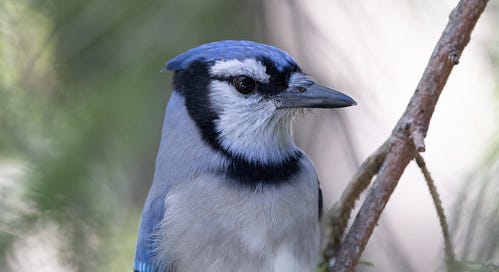




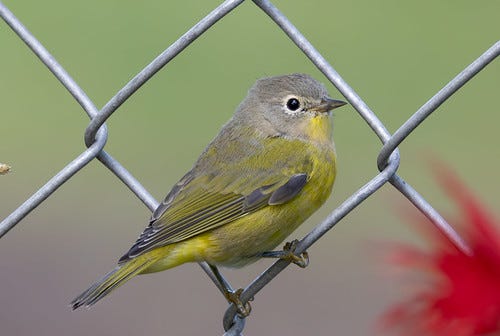
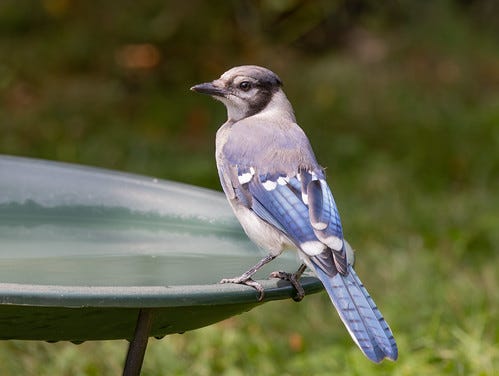

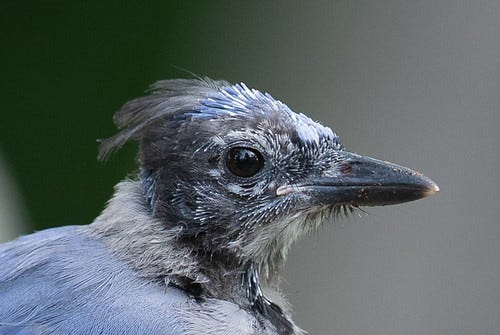
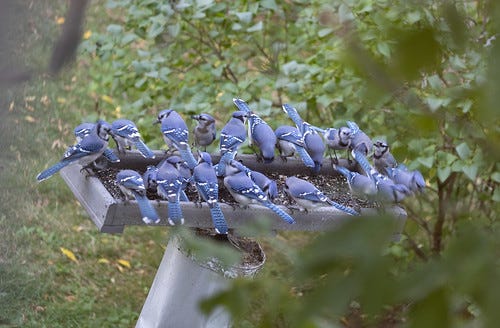
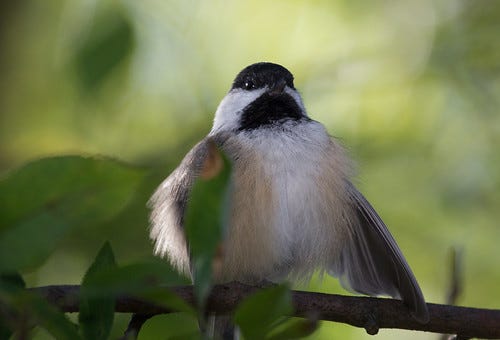

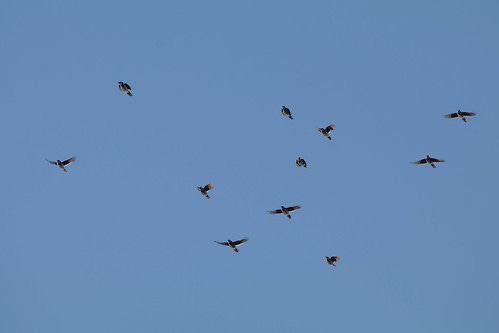
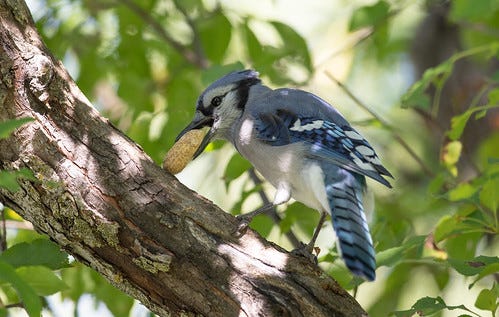
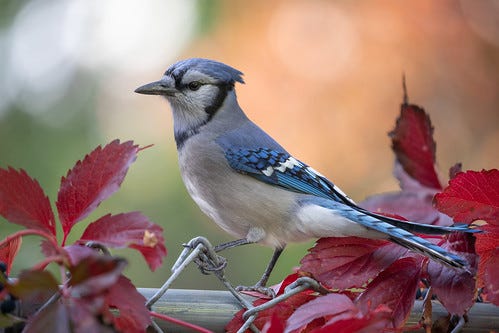
Very informative. Adding peanut butter to our suet is not doing any favours for birds. Who knew?